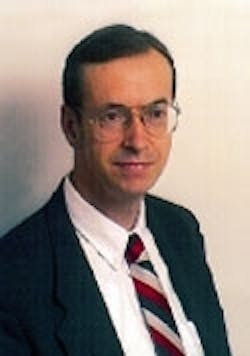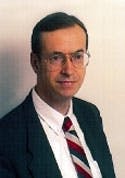Efforts begin to define spectral bands
When the OH (water) absorption peak around 1383 nm is absent from optical fibers, system designers have available a seamless spectrum covering all wavelengths from approximately 1260 to 1610 nm. Various parts of this spectrum are being characterized by letters and numerical "window" designations. While these bands, or windows, are useful concepts for trade and commerce, there is no accepted agreement yet on nomenclature or boundaries for the bands.
Recognizing the need for such agreement, a joint meeting of fiber and system experts within the International Telecommunication Union (ITU) Study Group 15 initiated an effort in this direction at their October meeting in Nara, Japan. Since transmitters, receivers, fibers, and optical amplifiers all influence the choice of band boundaries, many factors must be considered in the decision process.
John Eaves of Lucent Technologies and chair of the joint meeting will rely on inputs from the ITU experts for Q.15/15 (fibers), Q.16/15 (systems), and Q.17/15 (components). The resulting document (whose exact format is not yet clear) should encourage a common usage to minimize confusion.
The benefits of common usage are evident in the lower reaches of the electromagnetic spectrum. In its Radio Regulations, the ITU many years ago divided the 30-Hz to 300-GHz spectrum into contiguous decades designated ELF, VF, VLF, LF, MF, HF, VHF, UHF, SHF, and EHF. When the upper end of this spectrum was used for radar, a different division of bands evolved with the letter designations P, L, S, X, K, Q, V, and W.
Formal proposals have yet to be made for the optical spectrum, but some usage has appeared while awaiting official sanction:
- The "second window" (approximately 1260 to 1360 nm). The dispersion-unshifted singlemode fiber described in ITU Recommendation G.652 was originally intended for this window, but is now frequently used in the third window as well. G.652's chromatic-dispersion calculation covers the range from 1260 to 1360 nm.
- The "fifth window" (approximately 1350 to 1450 nm). Until recently, this band was unavailable because of the OH absorption peak at 1383 nm. Steps are now being taken in standards bodies to recognize the opening of this window.
- The "S-band" (short-wavelength--approximately 1440 to1500 nm). Like the "fifth window," this band is now receiving greater attention.
- The "C-band" (central, or conventional--approximately 1525 to 1562 nm). This band, also known as the "third window," is where erbium-doped fiber amplifiers (EDFAs) are most efficient. ITU Recommendation G.692, "Optical Interfaces for Multichannel Systems with Optical Amplifiers," defines a frequency grid covering the wavelength range of 1528 to1561 nm.
- The "L-band" (long-wavelength--approximately 1575 to 1610 nm), also known as the "fourth window." EDFAs are now available to at least 1605 nm, and current production fibers and cables are also usable in this range. The definition of the L-band and specifications within it are currently a high priority in the standards arena.
William B. Gardner represents Lucent Technologies, Norcross, GA, on several fiber standards committees. He can be contacted at tel: (770) 798-2674; fax: (770) 798-4654; e-mail: [email protected].

